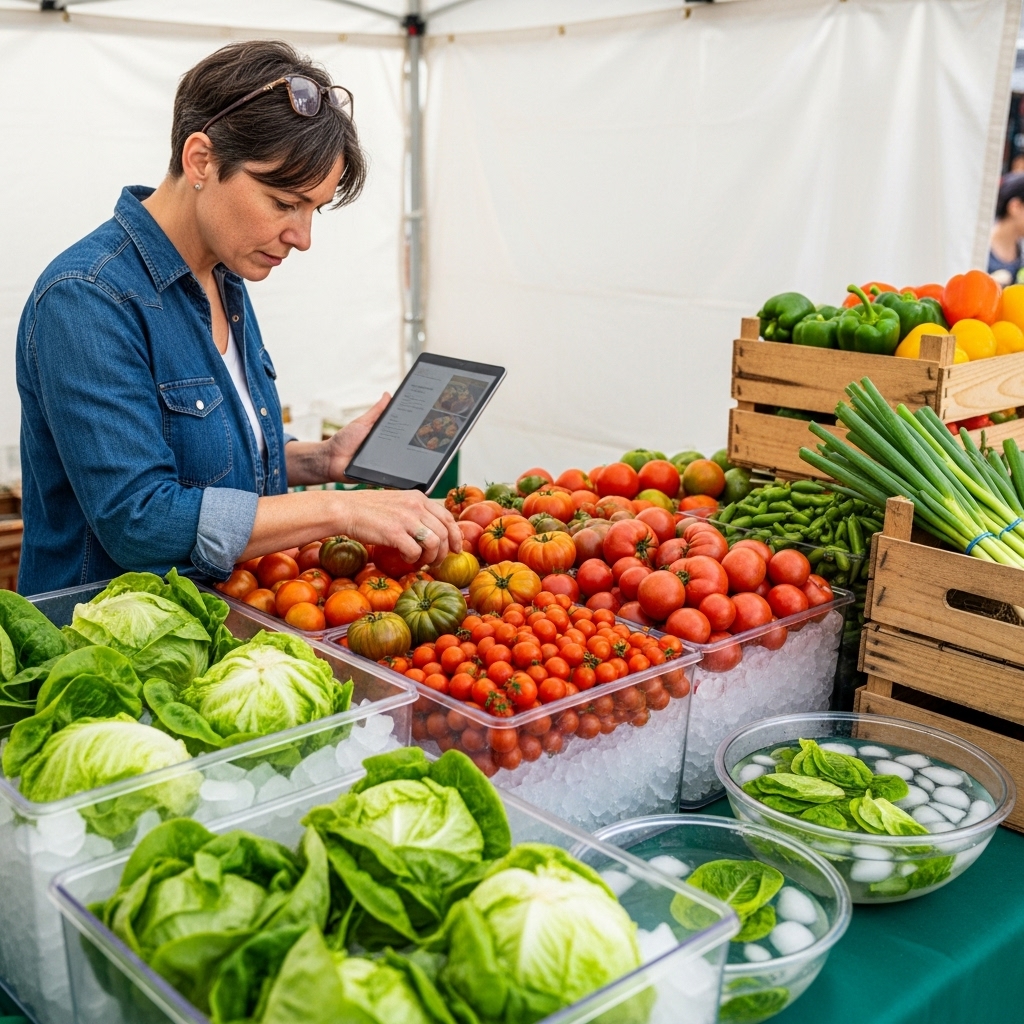Advanced Troubleshooting for Naperville Fresh Market Shoppers
Even experienced shoppers in Naperville, Illinois encounter challenges at the fresh market: inconsistent availability, unpredictable weather, storage hiccups, and recipe ruts. This advanced guide helps you diagnose and resolve those issues quickly so your market routine stays smooth and rewarding. Begin with a proactive mindset—scan current weekly deals to anticipate what is abundant, then form backup plans for ingredients likely to sell out. With a toolkit of substitution strategies, storage techniques, and vendor communication tips, you will be ready to pivot gracefully and keep your meals inspired no matter what the market throws your way.
Think of troubleshooting as a continuous loop: observe, analyze, adapt, and record. Each market visit provides data you can use to refine your approach. Track what sells quickly, which vendors align with your taste, and how seasonal shifts affect your cooking. Over time, you will identify patterns and create personalized playbooks that save time and reduce stress.
Problem: Your Target Ingredient Sells Out
Arriving to find empty bins where your desired item should be is frustrating, but solvable. Start by identifying function rather than fixating on the exact ingredient. If you wanted heirloom tomatoes for a salad, consider cherry tomatoes, roasted peppers, or even thinly sliced cucumbers dressed with a bright vinaigrette. For leafy greens, swap spinach for baby kale or chard. If sweet corn is gone, pivot to roasted carrots or sautéed zucchini for a similarly comforting side. The goal is to preserve the dish’s texture, color, and flavor profile even if the specific ingredient changes.
Build relationships with vendors to mitigate shortages. Politely ask when a product usually arrives, how quickly it sells, and whether preorders are possible. Some vendors will set aside items if you message them early or stop by the stall at opening. Keep notes on timing so you can arrive strategically for high-demand items next time.
Problem: Produce Quality Varies Week to Week
Quality swings can stem from weather, harvest timing, or transport. If berries are softer than usual, use them immediately in compotes, smoothies, or quick sauces instead of eating them out of hand. If tomatoes look pale, roast them to concentrate flavor. When greens are slightly wilted, refresh them in ice water before drying thoroughly. Treat deviations as an invitation to switch techniques: dry heat for lackluster flavor, moist heat for tougher textures, and quick raw applications for exceptional items.
Calibrate your inspection routine. For fruit, gently smell near the stem and check for even color. For greens, look for lively stems and crisp edges rather than pristine outer leaves alone. If a vendor’s quality dips repeatedly, discuss it respectfully; they may offer a different variety or harvest suggestion that better meets your needs.
Problem: Overbuying and Waste
Overflowing produce drawers often result from enthusiastic impulse buying. Counter this by assigning a job to every item before you purchase it. If you cannot quickly name a dish or two, postpone. When you get home with more than expected, triage immediately: cook the most perishable produce first, roast extra vegetables, and freeze surplus in labeled containers. Consider a mini preserving session for gluts—quick pickles, herb pestos, or fruit compotes. These strategies turn excess into assets and extend the joy of your market haul.
Another technique is to establish a weekly baseline menu that absorbs variability. For example, plan a grain bowl night every week that welcomes any combination of roasted vegetables, greens, and a simple sauce. Build a soup or frittata habit that uses odds and ends efficiently. By reserving a couple of flexible meals, you create a safety net for the unexpected.
Problem: Storage Failures
If lettuce collapses prematurely or herbs blacken, the culprit is often moisture mismanagement or temperature extremes. Wash greens promptly, spin dry, and store them loosely with a towel to absorb condensation. Keep tomatoes at room temperature and refrigerate only when fully ripe and you need to slow further ripening. Herbs last longer when treated like flowers—trim stems, place in a jar of water, and cover loosely in the refrigerator. Label containers clearly so you reach for delicate items first.
For berries, avoid washing until just before use; excess moisture accelerates spoilage. If you notice bruising, move them to a shallow container to prevent pressure damage. Store root vegetables in a cool, dark place, and separate greens from roots for items like carrots and beets to extend life. These small adjustments significantly reduce waste and frustration.
Problem: Recipe Ruts
When the market feels repetitive, refresh your approach with themed weeks: Mediterranean salads with tomatoes and cucumbers, Latin-inspired salsas and grilled vegetables, or Asian-style stir-fries with snap peas, bok choy, and aromatics. Pick a culinary lens and let it guide your stall choices. Ask vendors about varieties you have not tried and how they use them at home. A single new herb or spice blend can transform familiar produce into something exciting.
Adopt a learning mindset by setting micro-goals. One week, master quick pickles; the next, perfect oven-roasted tomatoes; then try grilling stone fruit. Rotating techniques builds a broader toolkit and helps you see every seasonal shift as an opportunity instead of a constraint.
Problem: Weather Disruptions
Heat, rain, or wind can reshape both supply and your shopping experience. On hot days, shop perishables first, use insulated inserts, and avoid leaving items in a parked car. In the rain, bring a water-resistant bag and wipe produce dry when you get home to prevent mold. Windy days require extra care with delicate items and packaging that can double as protection. Remember that weather also impacts what vendors can harvest; if something is missing, ask when it might return and plan alternatives for the week.
Weather can also affect foot traffic and lines. Adjust your arrival time and route based on conditions, and keep an eye out for stalls that shift their setup to accommodate the elements. You will learn which vendors are resilient and how to shop efficiently when conditions are less than ideal.
Problem: Long Lines and Crowded Aisles
Busy markets are a sign of a thriving community, but they can test your patience. Create a plan that prioritizes the most time-sensitive stops first, then hit quieter stalls while lines shrink. Travel light to move comfortably, and step aside to review your list rather than blocking pathways. When possible, pay quickly and gather questions into one brief conversation so you do not bottleneck the stall. If you shop regularly, you will develop a sense of which vendors are fastest at checkout and which times are less congested.
Consider shopping in pairs: one person waits in line while the other scouts new items or grabs staples from nearby stalls. Communicate by text to keep the process smooth and avoid duplicate purchases. Small teamwork saves time and improves the experience for everyone around you.
Problem: Dietary Constraints within a Household
Managing multiple diets under one roof can complicate market decisions. Solve this by building mix-and-match components: a base of greens or grains, a couple of roasted vegetables, and two sauces with different flavor profiles. Each diner customizes their plate without extra cooking steps. At the market, ask vendors to recommend varieties that work well across preparations, such as firm tomatoes for slicing and roasting or mild peppers that suit both raw and cooked dishes.
Label your fridge zones clearly so shared items are easy to find. Keep allergens separated and assign specific containers or shelves as needed. With a little organization, a diverse household can eat together without compromising individual needs.
Mid-Season Optimization and Data Tracking
To refine your routine, collect simple data points: arrival time, stalls visited, items purchased, prep time at home, and what went unused. Review weekly to identify bottlenecks or patterns like consistently overbuying greens or running short on fruit. Make one change at a time and measure the effect. If quality or availability fluctuates, note weather correlations and vendor updates so you can plan accordingly.
Digital photos of stall signs and ingredient labels help you remember varieties and sources. Over time, create a short list of go-to vendors for categories you rely on. Keep substitution charts handy in your notes app so you can pivot quickly when inventory surprises you. This approach turns challenges into a continuous improvement cycle.
Advanced Purchasing Strategies
If you cook frequently, consider coordinated buying. Establish a rotation that covers major categories—greens, roots, alliums, fruit, dairy, and proteins—so you never run out of essentials. When you spot peak-season abundance, plan batch cooking or preserving to capture flavor for later months. Ask vendors about seconds suitable for sauces and jams and request guidance on ripeness windows. Thoughtful bulk purchasing can be efficient without overwhelming your storage if you prep promptly after returning home.
Keep an eye on products that complement each other. For instance, pair tomatoes with basil and fresh mozzarella in summer, or combine winter squash with onions and hearty greens for easy roasts. By aligning purchases with natural pairings, you simplify meal planning and reduce decision fatigue during busy weeks.
Frequently Asked Questions
Q: How do I avoid disappointment when a favorite item is missing? A: Arrive earlier, develop substitutions based on function and texture, and ask vendors about typical arrival times or preorder options.
Q: What is the fastest way to stabilize wilting greens? A: Submerge them in ice water for a few minutes, then dry thoroughly and store with a towel to manage moisture.
Q: How can I keep berries from molding quickly? A: Store them dry, avoid washing until use, and move bruised berries to a shallow container to prevent pressure damage.
Q: How do I manage shopping with different diets at home? A: Prepare mix-and-match components and clearly label fridge zones. Choose versatile ingredients that perform well across cooking methods.
Q: What should I track each week? A: Note arrival times, vendor choices, items purchased, prep time, and any leftovers. Adjust one variable at a time to see what improves your routine.
Keep Your Market Routine Resilient
With an analytical mindset and a few reliable playbooks, you can overcome common obstacles and enjoy the best of Naperville’s fresh market every week. Approach each visit as an experiment, refine your storage and prep habits, and nurture relationships with vendors who match your taste and values. When you plan your next trip, glance at current weekly deals, outline substitutions for high-demand items, and set aside time for quick post-market prep. These practices keep your meals delicious, your kitchen organized, and your market days consistently gratifying.




